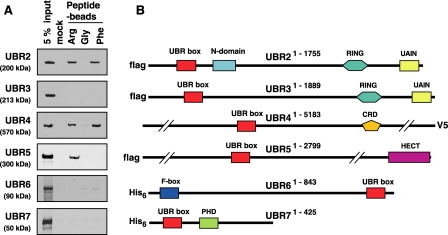FIGURE 2.
The binding properties of the UBR box family members to type-1 and type-2 destabilizing N-terminal residues. A, the X-peptide pull-down assay with overexpressed, full-length UBR proteins: UBR2, UBR3 (in S. cerevisiae cells), UBR4, UBR5 (in COS7 cells), and UBR6 and UBR7 (in the wheat germ lysates). Precipitates were analyzed by immunoblotting (for UBR2, UBR3, UBR4, and UBR5) with tag-specific antibodies as indicated in B or autoradiography (for UBR6 and UBR7). B, the structures of UBR box proteins. Shown are locations of the UBR box, the N-domain, and other E3-related domains. UBR, UBR box; RING, RING finger; UAIN, UBR-specific autoinhibitory domain; CRD, cysteine-rich domain; PHD, plant homeodomain; HECT, HECT domain.

